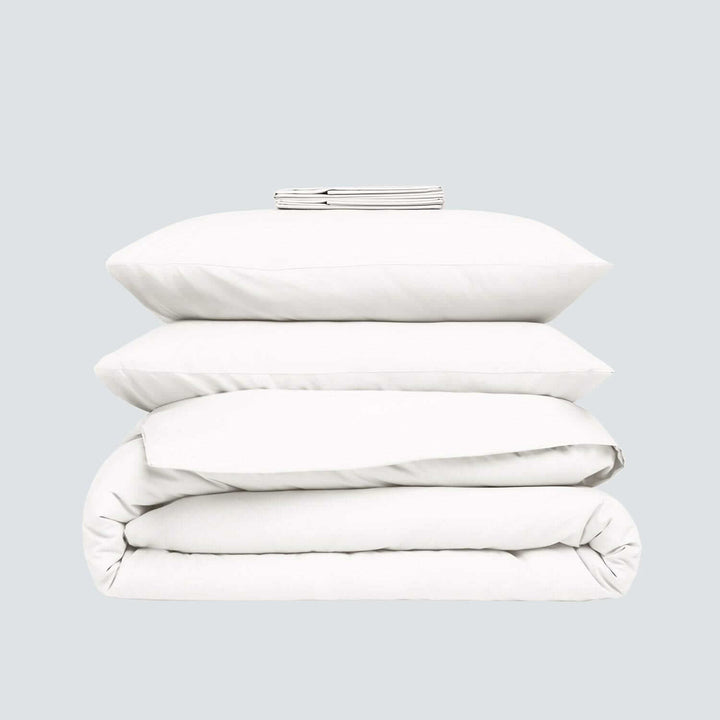Table of Contents
- Why Choosing Sustainable Bed Linen Matters
- Types of sustainable bed linen materials
- Invest in Quality, Reap the Benefits
- In Summary
- Factors to consider when buying sustainable bed linen
- Understanding the Environmental Impact: Natural Fibres vs. Synthetic Fabrics
- How to care for sustainable bed linen
- Where to buy sustainable bedding
- Conclusion: Making the sustainable choice for bed linen
- FAQs on Wool Duvet Inserts, Comforters & Sustainable Bedding
Why Choosing Sustainable Bed Linen Matters
Your sheets tell a story — of comfort, care, and the values you bring into your home. Choosing sustainable bed linen turns every night’s rest into an act of restoration, for both you and the earth.
There’s something deeply grounding about sinking into organic cotton sheets or natural linen bedding that’s been crafted with care. The softness feels earned, not synthetic — the kind that comes from eco-friendly bed linen made to last, not landfill. True luxury isn’t just how your sheets feel, but how they’re made. Sustainable bedding transforms your nightly ritual into something more meaningful: a gentle act of restoration for you and the planet.
As the world wakes up to the hidden costs of fast textiles, conscious homes are turning toward ethical bedding brands that prioritize craftsmanship, renewable materials, and transparency. The result? Breathable fabrics that help you sleep better naturally — and a calmer, cleaner home that reflects your values. Because the path to a good night’s sleep starts with what touches your skin and what supports the world around it.
When you choose sustainable bed linen, you’re not just selecting a product — you’re embracing a philosophy. Every thread of our non-toxic bedding is woven with intention: to reduce waste, protect ecosystems, and deliver comfort that endures.
These long-lasting bed sheets are designed to move with you through every season, becoming softer over time while maintaining their breathable, hypoallergenic nature. It’s time to view your bedding as more than décor — it’s the foundation of a truly sustainable home essential and a restful, regenerative lifestyle.
Choosing sustainable bed linen offers a range of benefits, including:
- Eco-friendly materials: Sustainable bedding is made from natural, renewable materials such as organic cotton, linen, or bamboo, reducing the environmental impact of conventional bedding production.
- Healthier for you: These materials are often hypoallergenic, breathable, and free from harmful chemicals, promoting a healthier and more comfortable sleep environment.
- Support for ethical practices: By opting for sustainable bedding, you support fair trade practices and ethical labor conditions, contributing to a more socially responsible industry.
- Long-lasting quality: Sustainable bedding is typically constructed with durability in mind, ensuring that your investment will last longer and reduce the frequency of replacements, ultimately reducing waste.
Types of sustainable bed linen materials
When it comes to sustainable bedding materials, there are a few options to consider. Common materials for sustainable bed linen include organic cotton, linen, bamboo, and Tencel. These materials are known for their eco-friendly production processes and biodegradable properties, making them excellent choices for those looking to make environmentally conscious purchases. Understanding the differences between these materials can help you make an informed decision when shopping for sustainable bedding.
Regenerative Organic Cotton Sheet Set – Soft, Breathable & Sustainable

$189.00
Softer Sheets. Cleaner Sleep. Our organic cotton sheet set are simply better for the earth, and for your sleep. Grown on low-impact regenerative farms that actively heal the soil, our cotton is then woven and finished responsibly. This process eliminates… Read more
Invest in Quality, Reap the Benefits
When it comes to sheets, opting for fewer, higher-quality options can significantly enhance your sleeping experience and offer long-term advantages. But why should you consider buying less, yet better?
Durability and Longevity
High-quality sheets, such as those made from linen or Egyptian cotton, are renowned for their durability. They're crafted to withstand years of use, retaining their softness and structural integrity over time. By investing in these superior materials, you may find yourself replacing your sheets less often—saving money and reducing waste in the long run.
Versatility in Design
Premium sheets often come in timeless, versatile colors and designs. Brands like Brooklinen and Parachute offer a palette that harmonizes with a wide range of bedroom aesthetics, allowing you to create a cohesive look effortlessly. This means that even if you switch up your room's decor, your sheets will remain a stylish staple.
Eco-Friendly Choice
Quality over quantity aligns with sustainable practices. By choosing sheets that last, you're reducing your environmental footprint, as fewer resources are spent on making, transporting, and discarding textiles. This mindful purchasing helps support manufacturers who prioritize eco-friendly practices, ensuring a better planet for future generations.
Enhanced Comfort and Sleep
Top-tier sheets are crafted for comfort. With options like organic cotton or hypoallergenic materials, you can enjoy a more restful sleep, free from irritation or discomfort. The smooth, breathable fabric fosters a cooler, more comfortable environment, promoting better quality rest.
Sustainable & Regenerative Bedding Bundle | No More Night Sweats, Just Deeper Sleep

$598.40
$748.00
Cooler Nights & Deeper Sleep — Every Night Elevate your sleep with the only sustainable bundle crafted from regenerative New Zealand wool and organic cotton for true all-season comfort. These breathable, eco-friendly fibers naturally wick away heat and moisture to… Read more
In Summary
Choosing superior sheets over multiple low-quality alternatives is an investment in comfort, sustainability, and style. It’s about making choices that benefit not just your present needs but also contribute positively to the environment and your budget over time.
Factors to consider when buying sustainable bed linen
When buying sustainable bedding, it's essential to consider a few factors to make an informed choice.
- Consider the materials used, such as organic cotton, linen, or bamboo, which are more environmentally friendly and biodegradable.
- Look for certifications like Global Organic Textile Standard (GOTS) or OEKO-TEX Standard 100 to ensure the product meets specific environmental and social criteria.
- Pay attention to the production process, such as whether it's water-efficient, uses non-toxic dyes, and employs fair labor practices.
- Consider the durability of the bed linen, as sustainable options are usually designed to last longer, reducing the need for frequent replacements.
- Factor in the washing and care instructions to understand the environmental impact of maintaining the bed linen.
Understanding the Environmental Impact: Natural Fibres vs. Synthetic Fabrics
When it comes to environmental impact, the production of natural fibres and synthetic fabrics differ significantly. Here's a closer look at how farming natural fibres and manufacturing synthetic materials contrast in their ecological effects:
Natural Fibers: A Greener Choice
Sustainable Farming Practices:
- Natural fibres, such as cotton, linen, and hemp, are grown using farming techniques that can be inherently sustainable.
- These fibres are derived from plants that can be cultivated with regenerative agricultural practices, which enhance soil health and biodiversity.
Biodegradability:
- Once they reach the end of their lifecycle, natural fibres decompose naturally, reducing landfill waste and contributing to a circular economy.
Lower Carbon Footprint:
- Farming processes for natural fibres often involve fewer greenhouse gas emissions compared to the energy-intensive manufacturing of synthetic fabrics.
Synthetic Fabrics: Challenges for the Environment
Energy-Intensive Production:
Synthetic materials like polyester and nylon are produced using petrochemicals, which require significant energy to process.
- This production contributes to higher carbon emissions and an increased reliance on non-renewable resources.
Non-Biodegradable:
- Unlike natural fibres, synthetic fabrics do not break down easily. They persist in landfills, creating long-term environmental concerns.
Microplastic Pollution:
- Washing synthetic textiles can release microplastics into waterways, contributing to pollution and harming aquatic ecosystems.
By choosing products made from natural fibres, consumers can support a more sustainable approach that aligns with environmental conservation goals. The choice between natural and synthetic materials holds significant implications for our planet's health and the legacy we leave behind.
Thread count and weave of sustainable bedding
When choosing sustainable bedding, it's essential to consider the thread count and weave. Thread count refers to the number of threads woven into a square inch of fabric.
Generally, a higher thread count indicates a softer and more luxurious feel. However, sustainable bed linen with a thread count of 300 to 600 is usually sufficient for comfort and durability. As for the weave, it determines the texture and breathability of the fabric. The most common weaves for sustainable bed linen are percale and sateen. Percale is known for its crisp and matte finish, while sateen has a smooth and lustrous surface. Consider these factors to ensure your sustainable bed linen meets your comfort and quality standards.
Color and design options for sustainable bedding
You'll find a wide range of color and design options when looking for sustainable bedding. Sustainable bedding comes in various colors and patterns, allowing you to find options that suit your style and bedroom decor. From soft pastels to bold prints, you can find sustainable bed linen that matches your preferences. Many sustainable bedding brands offer various design options, including classic, modern, and bohemian styles, so you can find the perfect look for your bedroom. So, when shopping for sustainable bedding, take some time to explore the color and design options available to find the best fit for your bedroom.
Eco-friendly practices of sustainable bed linen production
Eco-friendly practices are essential in sustainable bed linen production. This includes using organic and natural fibers like cotton, linen, or bamboo.
These materials are grown and harvested without harmful chemicals, making them better for the environment and your health. Additionally, sustainable production involves reducing water and energy usage during manufacturing and minimizing waste. Look for certifications such as Global Organic Textile Standard (GOTS) or OEKO-TEX Standard 100 to ensure the bed linen meets sustainable and eco-friendly standards.
How to care for sustainable bed linen
To care for sustainable bedding, it's essential to follow these guidelines:
- Washing: Use a gentle, eco-friendly detergent in cold or lukewarm water to preserve the fabric's integrity.
- Drying: Air-drying is the best option to reduce energy consumption and maintain the linen's quality. If using a dryer, opt for a low-heat setting.
- Ironing: Linen tends to wrinkle but embraces the natural texture rather than ironing excessively. If needed, iron while the fabric is slightly damp for best results.
- Storage: Store bed linen in a cool, dry place to prevent mildew and maintain freshness. Avoid plastic bags and opt for breathable fabric storage bags if necessary.
Where to buy sustainable bedding
You can buy sustainable bed linen from various sources, including eco-friendly online retailers, organic bedding stores, specialty home goods stores, and some major department stores that offer sustainable options. It's essential to look for certifications like GOTS or OEKO-TEX when purchasing to ensure the sustainability of the products. Watch for brands known for their commitment to environmentally friendly practices and ethical sourcing.
Regenerative Organic Cotton Sheet Set – Soft, Breathable & Sustainable

$189.00
Softer Sheets. Cleaner Sleep. Our organic cotton sheet set are simply better for the earth, and for your sleep. Grown on low-impact regenerative farms that actively heal the soil, our cotton is then woven and finished responsibly. This process eliminates… Read more
Better Sleep with Natural Fibers
Sustainable bed linen isn’t just good for the planet—it’s good for your sleep, too. Natural fibers like organic cotton, linen, and Tencel are highly breathable, wicking away moisture and regulating temperature to keep you comfortable all night. Unlike synthetic fabrics that trap heat and moisture, sustainable materials help prevent overheating and night sweats, promoting deeper, uninterrupted rest.
The Long-Term Value of Sustainable Bedding
While eco-friendly bed linen may have a higher upfront cost, its durability makes it a smart long-term investment. High-quality organic fabrics last longer, resist wear and tear, and maintain their softness after repeated washes. Choosing sustainable options means fewer replacements over time, reducing waste and ultimately saving money while maintaining a luxurious sleep experience.
Conclusion: Making the sustainable choice for bed linen
When choosing sustainable bed linen, prioritize materials like organic cotton, linen, or bamboo, as they are eco-friendly and renewable. Look for certifications such as GOTS, OEKO-TEX, or USDA Organic to ensure the product's sustainability. Consider the longevity and durability of the bed linen, as well as the eco-friendly production methods used by the manufacturer. By making a sustainable choice for your bed linen, you reduce environmental impact and support ethical and responsible practices in the textile industry.
Learn More About Our Sustainable Bed Linen
FAQs on Wool Duvet Inserts, Comforters & Sustainable Bedding
What makes sustainable bed linen different from regular bedding?
Sustainable bedding is made from responsibly sourced natural fibers like organic cotton and natural linen, produced without harmful chemicals or excess water use. It offers breathability, durability, and comfort while minimizing environmental impact.
Are eco-friendly bed linens really better for sleep?
Yes. Eco-friendly bed linen made from breathable fabrics like organic cotton sheets helps regulate temperature and reduce skin irritation. You’ll sleep more comfortably and wake feeling refreshed, without exposure to synthetic materials or toxins.
How long do organic cotton sheets last compared to synthetic ones?
Organic cotton sheets and other sustainable bedding options typically outlast synthetics. Their natural fibers soften over time instead of breaking down, meaning you’ll enjoy years of use — and fewer replacements in the landfill.
Is sustainable bed linen worth the higher price?
Absolutely. Think of it as an investment in non-toxic bedding that benefits your health and the planet. With its long lifespan, superior comfort, and ethical production, sustainable linen delivers long-term value over cheaper, short-lived options.
How can I make my bedroom more sustainable beyond bed linen?
Pair your sustainable bed linen with other eco-conscious home essentials — such as wooden furniture, low-VOC paints, and energy-efficient lighting. Small swaps add up, transforming your space into a healthier, more regenerative retreat.



